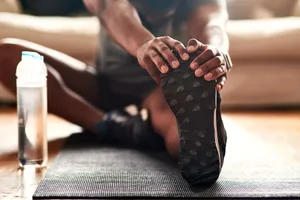Rodney McKinley found out he had peripheral arterial disease (PAD) in 2011, when his frequent walks dissolved into searing pain. “When I would lay down in bed to sleep, it felt like someone had a blowtorch under my toes,” he says.
McKinley had bypass surgery in his groin — with 32 staples — and two more bypasses in both lower legs. His pain eased for a year. But then it came back.
“I ate more painkillers than I did food,” says McKinley, 64, of Johnson City, TN. He tried many treatments, including hyperbaric oxygen therapy, which uses pressure to fill your blood with oxygen to help heal wounds.
When nothing helped, “my doctor finally said all he could do was amputation.”
McKinley had one leg amputated and spent 4 weeks in the hospital and in rehab. “I came home and tried to stay positive and get on with my life,” he says.
It took him a month to recover enough to get fitted with a prosthetic leg. But by then, his leg had contracted and wouldn’t straighten enough for him to wear his prosthesis.
During this difficult point, McKinley found support “out of the heavens.” His ex-wife traveled from England for a surprise visit, and stayed. She took McKinley to physical therapy three times a week until he got back on his feet. In January 2020, McKinley managed to take his first steps without his wheelchair or a walker — almost 9 years after his PAD diagnosis.
“She was so instrumental in my being able to walk again,” he says. Now, he can walk anywhere, sometimes even without his cane.
“The main thing that keeps me going is trying to stay positive.”
Kay Smith, a nurse practitioner who lives in west Scotland, traveled all over the United Kingdom to train medical professionals in wound care. Excruciating thigh cramps prevented her from driving. Soon after, even walking turned too painful. After a flurry of doctors and tests, Smith learned she had PAD and found herself in a wheelchair at age 54. Her doctors canceled an angioplasty to restore her blood flow when they found a blockage in her aorta, the main artery that carries blood from the heart to the rest of the body. On top of that, Smith was allergic to painkillers.
“Over the next few months, I was in a very dark place,” she says. “Something no one discusses is the mental health issues: anxiety and depression and isolation of illness.” Then COVID-19 struck.
Then, thanks to high technology, Smith discovered a way to bend her despairing reality.
She found a doctor who prescribes virtual reality (VR) for chronic pain. This technology creates a computer-generated, 3D, immersive environment that allows you to explore and even take part in activities using headsets and sometimes special gloves to help complete the illusion.
“He provided the equipment, and within hours, I was pain-free for the first time in years,” Smith says. “I had been an avid scuba diver and had dived all over the world. So, when immersed in my VR world, I went scuba diving. It gave me strength in that it reminded me I was still me. In some sense, it actually gave me back me.”
She still uses VR daily to help manage pain.
Smith next tapped into a large online PAD support network called The Way to My Heart. She began sharing her expertise on wound care. “At the same time, the care team helped me gain a strength mentality. I decided to not feel sorry for myself and start fighting,” she says.
A year and a half later, she had an endovascular treatment to clear her blockages. Five weeks afterward, she was fully upright again, dancing with her husband at a wedding, and clocking about 9,000 steps a day.
“There can be life with PAD,” Smith says. “But it’s a new and adapted lifestyle.”
Kevin Morgan is a trained veterinary pathologist who at age 78 still competes in Ironman races. But, since 2010, he’s done them with an abdominal aortic aneurysm (AAA) stent graft, which limits the amount of blood that reaches his legs when he’s training.
The Carrboro, NC, resident’s PAD symptoms first showed up around 2015. “I noticed problems with my feet getting numb in marathons,” Morgan says. At first, he thought the soreness and lack of circulation meant he wasn’t training enough. “I never linked it with PAD.”
His doctor diagnosed PAD during an annual stent exam with an ankle brachial index test, which contrasts blood pressure in the arms and legs.
The stent has put “absolute limits” on what he can do, Morgan says. There’s always the danger that running could dislodge the stent, so he modified his training. He rides a custom bike designed to lessen flexing in his hips. He swapped the rowing machine for an elliptical. He cut flip turns in the pool.
“The PAD and AAA have given me more empathy for people in the same boat,” Morgan says. With a shift in thinking, “You can always turn it around to make it a good thing. I think the real trick is to make it not about you, but about other people.”
Morgan also practices meditation and reads a lot. He’s also written many self-help books, including How to Train for Aging.
He’s also found joy in taking it slow. “A man has to know his limitations. So you learn to appreciate what you do get, not what you’ve lost due to the inevitable health changes of aging.” Plus, he adds, “You meet the nicest people at the back of the pack.”






